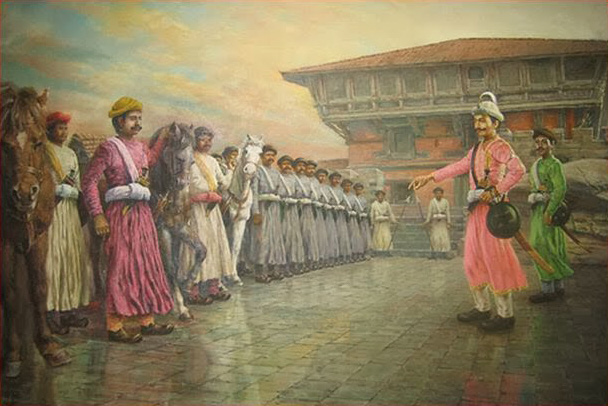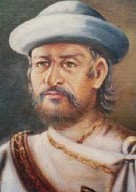|
Dhokal Singh Basnyat
Dhokal Singh Basnyat served as the governor of the Kumaon and Garhwal kingdoms. He is the youngest son of Senapati Shivaram Singh Basnyat and was the first owner of Narayanhiti Palace The Narayanhiti Palace Museum (Nepali: नारायणहिटी दरवार) is a public museum in Kathmandu, Nepal located east of the Kaiser Mahal and next to Thamel. The museum was created in 2008 from the complex of the former Nara .... Khaptadi Basnet Dynasty Development & Ancestry Committee. Retrieved March 15, 2017 References {{DEFAULTSORT:Basnyat, Dhokal Singh Year of birth missing[...More Info...] [...Related Items...] OR: [Wikipedia] [Google] [Baidu] |
Unification Of Nepal
The Unification of Nepal, also known as Expansion of Gorkha Kingdom, officially began in 1743 AD (1799 BS) after King Prithvi Narayan Shah of Gorkha launched an aggressive annexation campaign seeking to broaden his own kingdom's border. After conquering the Nepal Mandala, which consisted of the different city-states of the Kathmandu, Lalitpur, Kirtipur and Bhaktapur, Shah moved his hilly capital in Gorkha to the fertile and wealthy city of Kathmandu and adopted the name Nepal for the entire Gorkha Empire. The Shah dynasty would go on to expand the various warring kingdoms that once occupied parts of present-day Nepal into a nation-state that stretched up to the Sutlej River in the west and Sikkim-Jalpaiguri in the east. Before usage by the Gorkha Empire, the Kathmandu Valley was known as Nepal after the Nepal Mandala, the region's Nepal Bhasa name. Invasion of Nuwakot Prithvi Narayan Shah's annexation campaign began with the nearby kingdom of Nuwakot. Nuwakot marked the ... [...More Info...] [...Related Items...] OR: [Wikipedia] [Google] [Baidu] |
Shivaram Singh Basnyat
Shivaram Singh Basnyat ( ne, शिवराम सिंह बस्न्यात) was the military commander of Gorkha. After the conquest of Naldum area by the Gorkhalis, he along with Commander Bir Bhadra Thapa conquered Sanga, Panauti, Sankhu and adjacent areas. They received fierce resistance from the Kantipur Kingdom at Sangachok. He died in the defensive battle of Sanga Chowk during Unification of Nepal on 1803 B.S. Personal life He was born to Jayaram Singh Basnyat in the clan of Shreepali among Basnyats. He had four sons - Naahar Singh Basnyat, Kehar Singh Basnyat Kehar Singh Basnyat ( ne, केहरसिंह बस्न्यात) or Kehar Singh Basnet was a Nepalese military commander and warhero who led down his life in the Unification battles of Nepal. He was born in the illustrious clan of Shr ..., Abhiman Singh Basnet and Dhokal Singh Basnyat. His third son went on to become Supreme Commander of the Nepalese Army and Chief Minister ( Mulkazi) in ... [...More Info...] [...Related Items...] OR: [Wikipedia] [Google] [Baidu] |
Kumaon Kingdom
Kumaon Kingdom was an independent Himalayan kingdom in the eastern region of present-day Uttarakhand state of India. It was established around 7th century and remained an independent and sovereign kingdom until 1791. Etymology Kumaon is believed to have been derived from ''Kurmanchal'', meaning land of the Kurma Avatar (the tortoise incarnation of Lord Vishnu, the preserver according to Hinduism). The region of Kumaon is named after as such. During the time of the British control of the region, between 1815 and 1857 it was also known as ''Kemaon''. History Ancient Kumaon finds mention in the early Hindu scriptures as ''Manaskhand, according to'' Skanda Purana ''the region'' is believed to be the Birth place of Kurmavtar of Hindu god Vishnu. Prehistoric dwellings and Stone Age implements have been discovered in Almora and Nainital districts. Initially settled by Kol tribals, the region witnessed successive waves of Kiratas, Khasas and Indo-Scythians(sakas). Kunindas were t ... [...More Info...] [...Related Items...] OR: [Wikipedia] [Google] [Baidu] |
Garhwal Kingdom
Garhwal Kingdom was an independent Himalayan kingdom in the current north-western Himalayan state of Uttarakhand, India, founded in 688 CE by Kanak Pal, the progenitor of the Panwar dynasty that ruled over the kingdom uninterrupted until 1803 CE. The kingdom was divided into two parts during the British Raj, namely: the princely state ''of Garhwal and'' the ''Garhwal District'' of British India. During this period, the princely state of Garhwal was one of the States of the Punjab Hills which became part of the Punjab Hill States Agency although it was not under the Punjab Province administration. The princely state of Garhwal or Independent Garhwal consisted of the present day Tehri Garhwal district and most of the Uttarkashi district. This former state acceded to the Union of India in August 1949 CE. Etymology The exact origin of the word 'Garhwal' is unknown, though it is believed to be derived from the title ‘''Garh-wala''’ (Owner of Forts) given to the rul ... [...More Info...] [...Related Items...] OR: [Wikipedia] [Google] [Baidu] |
General
A general officer is an officer of high rank in the armies, and in some nations' air forces, space forces, and marines or naval infantry. In some usages the term "general officer" refers to a rank above colonel."general, adj. and n.". OED Online. March 2021. Oxford University Press. https://www.oed.com/view/Entry/77489?rskey=dCKrg4&result=1 (accessed May 11, 2021) The term ''general'' is used in two ways: as the generic title for all grades of general officer and as a specific rank. It originates in the 16th century, as a shortening of ''captain general'', which rank was taken from Middle French ''capitaine général''. The adjective ''general'' had been affixed to officer designations since the late medieval period to indicate relative superiority or an extended jurisdiction. Today, the title of ''general'' is known in some countries as a four-star rank. However, different countries use different systems of stars or other insignia for senior ranks. It has a NATO ran ... [...More Info...] [...Related Items...] OR: [Wikipedia] [Google] [Baidu] |
Narayanhiti Palace
The Narayanhiti Palace Museum (Nepali: नारायणहिटी दरवार) is a public museum in Kathmandu, Nepal located east of the Kaiser Mahal and next to Thamel. The museum was created in 2008 from the complex of the former Narayanhiti Palace (or Narayanhiti Durbar) following the 2006 revolution. Before the revolution, the palace was the residence and principal workplace of the monarch of the Kingdom of Nepal, and hosted occasions of state. The existing palace complex was built by King Mahendra in 1963, and incorporates an impressive array of courtyards, gardens and buildings. Etymology The name, ''Narayanhiti'' is made up of two words 'Narayana' and 'Hiti'. Narayan is the Hindu god Vishnu, whose temple is opposite the palace. '' Hiti'' means "water spout" in Newar Language, which is to the east of the main entrance in the precincts of the palace, a landmark that features prominently in local legends. [...More Info...] [...Related Items...] OR: [Wikipedia] [Google] [Baidu] |
Year Of Birth Missing
A year or annus is the orbital period of a planetary body, for example, the Earth, moving in its orbit around the Sun. Due to the Earth's axial tilt, the course of a year sees the passing of the seasons, marked by change in weather, the hours of daylight, and, consequently, vegetation and soil fertility. In temperate and subpolar regions around the planet, four seasons are generally recognized: spring, summer, autumn and winter. In tropical and subtropical regions, several geographical sectors do not present defined seasons; but in the seasonal tropics, the annual wet and dry seasons are recognized and tracked. A calendar year is an approximation of the number of days of the Earth's orbital period, as counted in a given calendar. The Gregorian calendar, or modern calendar, presents its calendar year to be either a common year of 365 days or a leap year of 366 days, as do the Julian calendars. For the Gregorian calendar, the average length of the calendar ... [...More Info...] [...Related Items...] OR: [Wikipedia] [Google] [Baidu] |
Year Of Death Missing
A year or annus is the orbital period of a planetary body, for example, the Earth, moving in its orbit around the Sun. Due to the Earth's axial tilt, the course of a year sees the passing of the seasons, marked by change in weather, the hours of daylight, and, consequently, vegetation and soil fertility. In temperate and subpolar regions around the planet, four seasons are generally recognized: spring, summer, autumn and winter. In tropical and subtropical regions, several geographical sectors do not present defined seasons; but in the seasonal tropics, the annual wet and dry seasons are recognized and tracked. A calendar year is an approximation of the number of days of the Earth's orbital period, as counted in a given calendar. The Gregorian calendar, or modern calendar, presents its calendar year to be either a common year of 365 days or a leap year of 366 days, as do the Julian calendars. For the Gregorian calendar, the average length of the calendar year (t ... [...More Info...] [...Related Items...] OR: [Wikipedia] [Google] [Baidu] |
Nepalese Politicians
Nepali or Nepalese may refer to : Concerning Nepal * Anything of, from, or related to Nepal * Nepali people, citizens of Nepal * Nepali language, an Indo-Aryan language found in Nepal, the current official national language and a language spoken in India * Nepal Bhasa, a Sino-Tibetan language found in Nepal, formerly the official national language * Nepalese literature * Nepalese cuisine * Nepalese culture * Nepali cinema * Nepali music Other uses * ''Nepali'' (film), a 2008 Indian Tamil-language film See also * Nepal (other) * * * Languages of Nepal * Nepal Nepal (; ne, :ne:नेपाल, नेपाल ), formerly the Federal Democratic Republic of Nepal ( ne, सङ्घीय लोकतान्त्रिक गणतन्त्र नेपाल ), is a landlocked country in S ... is a south Asian country with a population of nearly 30 million. {{disambiguation Language and nationality disambiguation pages ... [...More Info...] [...Related Items...] OR: [Wikipedia] [Google] [Baidu] |
Basnyat Family
Basnyat/Basnet family or Basnyat/Basnet dynasty ( ne, बस्न्यात वंश/बस्न्यात काजी खलक) was a Khas-Chhetri and a warlord clan family involved in the politics and administration of the Gorkha Kingdom and Kingdom of Nepal. This family got entry into Thar Ghar aristocracy group of Gorkha at the time of King Prithvi Narayan Shah. It was one of the four noble families to be involved in active politics of Nepal together with Shah dynasty, Pande family and Thapa dynasty before the rise of Rana dynasty. This family is descended from Shivaram Singh Basnyat, the commander of Gorkhali forces and a member of Shreepali Basnyat clan of Gorkha. This family was maritally linked to ''Kala'' (Black) Pande section of Pande dynasty through Chitravati Pande who married Kaji Kehar Singh Basnyat. This family was the last Kshatriya (Chhetri) political family to be wiped out from the central power by Jung Bahadur Rana of Kunwar family during the Bhandar ... [...More Info...] [...Related Items...] OR: [Wikipedia] [Google] [Baidu] |




